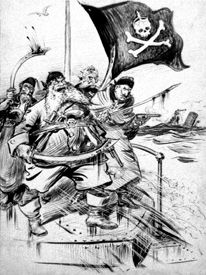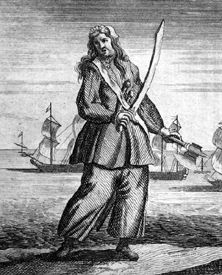
Pirates
John “Calico Jack” Rackham (1682-1720) – Commonly known as Calico Jack because of the colorful calico clothing that he wore, Rackham was an English pirate captain operating in the Bahamas and in Cuba during the “Golden Age of Piracy” (1650-1730). Born in England on December 26, 1682, nothing is known of his early life but by the early 18th century he had made his way to the New World.
The first recorded documentation of Rackham is when he was working as a quartermaster on Charles Vane’s sloop, the Ranger, in 1718. At this time, the crew primarily operated out of New Providence island in the Bahamas, which was such a notorious base for pirates that it was known as the “Pirates Republic.” After making their way north and robbing several ships outside of New York City, the Ranger encountered a large French man-of-war. The ship was at least twice as large as the Ranger and immediately began to pursue the pirates. Though the crew wanted to fight, Vane commanded a retreat from battle. But Jack Rackham spoke up, contesting the decision and suggesting they fight the larger vessel as it would have much treasure and would win them a larger ship. Vane; however, still refused, but of the crew, only 15 supported the captain’s decision, while the remaining 75 agreed with Calico Jack.
However, Vane declared that the captain’s decision was final despite the overwhelming support for Rackham’s cry to fight, and the Ranger and its crew fled the French man-of-war. But, the affair was not over.
On November 24, 1718, Calico Jack branded Captain Vane as a coward, called for his removal and asked for a vote from the crew to see if they agreed. Overwhelmingly the pirates approved and Vane was removed from the captaincy, making Rackham the next captain. The crew then set Vane and his 15 supporters adrift on a smaller boat, along with a small supply of ammunition and goods.
Rackham and his men then cruised the West Indies and the waters near Bermuda plundering small vessels close to the shore. In December, Rackham and his crew captured a Jamaican merchant ship called the Kingston. The ship had a rich cargo and the crew made the new vessel their flagship. Unfortunately, the pirates had been seen and the outraged merchants of Port Royal hired bounty hunters to go after the thieves. The bounty hunters caught up with the Kingston as it was anchored off Cuba in February 1719. The crew, in the meantime, were onshore and able to escape into the woods, but, they lost their ship and its cargo.

Anne Bonny, Lady Pirate
Next, Calico Jack and his crew made it to Nassau in the Bahamas, where British Governor Woodes Rogers had been sent to address the pirate problem. Rogers provided a general amnesty and royal pardon for any pirate ready to accept it in exchange for discontinuing their illegal endeavors. Captain Jack and his crew asked for the pardon, claiming that Captain Charles Vane had forced them to become pirates. Rogers, who hated Vane, granted the pardon and soon Rackham moved to New Providence. There, while frequenting the taverns, he met a woman named Anne Bonny. Though she was married to a sailor and government informant named James Bonny, the two began to have an affair. When James Bonny found out about the relationship Rackham offered to pay him to divorce her — a common practice at the time — but James Bonny refused.
The pair, along with a new crew, stole a sloop and returned to piracy in August 1720, voiding Rackham’s pardon. Rackham’s decision to have Bonny accompany him was highly unusual, as women were considered bad luck aboard ships. They then sailed the Caribbean for several months, taking over other pirate ships and often inviting crew members of other ships to join him. Bonny did not conceal her gender from her shipmates, though when pillaging she disguised herself as a man and participated in armed conflict.
Before long, Anne became pregnant and would give birth to a son in Cuba. What became of the boy remains unknown. Bonny quickly returned to the pirate life.
Somewhere along the line, another lady pirate by the name of Mary Read, who often disguised herself as a man, joined Rackham’s crew.
In September 1720, Governor Rogers issued a proclamation that Rackham and his crew had returned to piracy and soon a pirate hunter named Jonathan Barnet began the hunt for Calico Jack. Cruising along the coastline near Jamaica, Rackham and his crew had captured a number of small vessels, word of which soon reached Barnet.
Under a commission from Nicholas Lawes, the Governor of Jamaica, Barnet and his crew made a timely attack on Rackam’s anchored ship the William. Most of Rackham’s pirates put up little resistance as many of them were too drunk to fight. They were celebrating all night because they managed to capture a Spanish commercial ship. However, Read and Bonny fought fiercely and managed to hold off Barnet’s troops for a short time. In the end, the women were overwhelmed and Rackham and his crew were taken to Jamaica to stand before the court. As word leaked that women pirates were part of the crew the trial became a big sensation.
Captain Jack and the male members of his crew were tried on November 16, 1720, and were sentenced to hang. Anne was allowed to visit Rackham one last time before his execution took place, but rather than consoling him, she stated: “Had you fought like a man, you need not have been hanged like a dog.”
Anne and Mary were tried a week after Rackham and his men were executed. After being convicted, Read and Bonny both “pleaded their bellies”, asking for mercy because they were both pregnant, and in accordance with English common law, both women received a temporary stay of execution until they gave birth. Mary Read died in prison from fever in 1721, but the fate of Anne Bonny is unknown.
Though there are no records of Bonny’s release or execution, it is said that her father bought her freedom from Jamaican Governor Lawes and she returned to Charleston, where she gave birth to Rackham’s child.
Though Calico Jack was relatively a small-time pirate, his legacy received fame for two reasons, the first being the fact that he sailed with female pirates. The second is that his iconic flag, displaying a skull and crossbones, came to represent piracy itself.
© Kathy Weiser/Legends of America, Updated December 2021.
